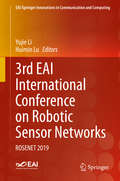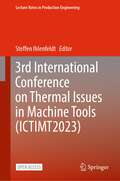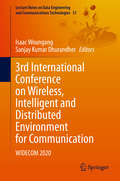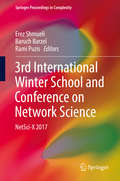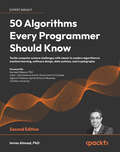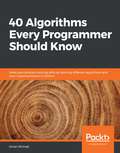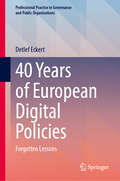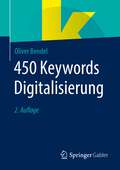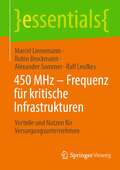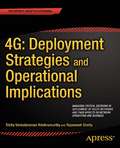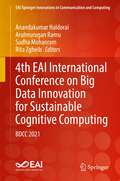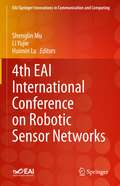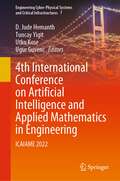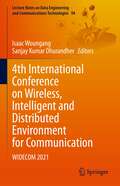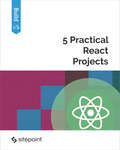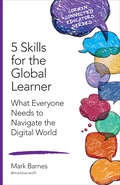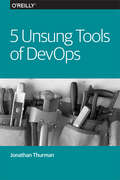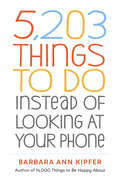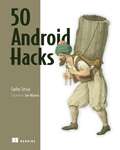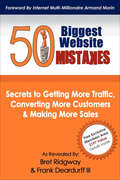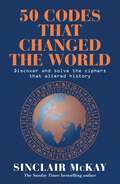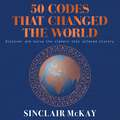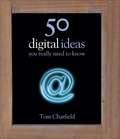- Table View
- List View
3rd EAI International Conference on IoT in Urban Space (EAI/Springer Innovations in Communication and Computing)
by Helena Rodrigues Kristof Van Laerhoven Rui JoséThis proceedings presents the papers from Urb-IoT 2018 - 3rd EAI International Conference on IoT in Urban Space, which took place in Guimarães, Portugal on 21-22 November 2018. The conference aims to explore the emerging dynamics within the scope of the Internet of Things (IoT) and the new science of cities.The papers discuss fusion of heterogeneous urban sources, understanding urban data using machine learning and mining techniques, urban analytics, urban IoT infrastructures, crowd sourcing techniques, incentification and gamification, urban mobility and intelligent transportation systems, real time urban information systems, and more. The proceedings discuss innovative technologies that navigate industry and connectivity sectors in transportation, utility, public safety, healthcare, and education. The authors also discuss the increasing deployments of IoT technologies and the rise of the so-called 'Sensored Cities'‚ which are opening up new avenues of research opportunities towards that future.
3rd EAI International Conference on Robotic Sensor Networks: ROSENET 2019 (EAI/Springer Innovations in Communication and Computing)
by Huimin Lu Yujie LiThis proceedings presents the papers of the 3rd EAI International Conference on Robotic Sensor Networks (ROSENET 2019). The conference explores the integration of networks and robotic technologies, which has become a topic of increasing interest for both researchers and developers from academic fields and industries worldwide. The authors posit that big networks will be the main approach to the next generation of robotic research, The book discusses how the explosive number of network models and increasing computational power of computers significantly extends the number of potential applications for robotic technologies while also bringing new challenges to each network's community. The conference provided a platform for researchers to share up-to-date scientific achievements in this field. The conference took place August 17, 2019, Kitakyushu, Japan.Presents the proceedings of the 3rd EAI International Conference on Robotic Sensor Networks (ROSENET 2019), August 17, 2019, Kitakyushu, JapanFeatures papers on robotic technologies for healthcare, medicine, military and moreIncludes perspectives from a multi-disciplinary selection of global researchers, academics, and professionals
3rd International Conference on Thermal Issues in Machine Tools (Lecture Notes in Production Engineering)
by Steffen IhlenfeldtThis open access conference proceedings contains all the papers presented at the ICTIMT 2023, the 3rd International Conference on Thermal Issues in Machine Tools. The event takes place in Dresden, the capital of Saxony, from March 21-23 2023. The conference is organized by the Chair of Machine Tools Development and Adaptive Controls of the Technische Universität Dresden.
3rd International Conference on Wireless, Intelligent and Distributed Environment for Communication: WIDECOM 2020 (Lecture Notes on Data Engineering and Communications Technologies #51)
by Isaac Woungang Sanjay Kumar DhurandherThis book presents the proceedings of the 3rd International Conference on Wireless Intelligent and Distributed Environment for Communication (WIDECOM 2020), sponsored by Ryerson University, Toronto, Canada, May 6-8, 2020. The WIDECOM conference solicits papers addressing issues related to new dependability paradigms, design, and performance of dependable network computing and mobile systems, as well as issues related to the security of these systems. The goal of the conference is to provide a forum for researchers, students, scientists and engineers working in academia and industry to share their experiences, new ideas and research results in the above-mentioned areas.Presents the proceedings of the International Conference on Wireless Intelligent and Distributed Environment for Communication (WIDECOM 2020), Ryerson University, Toronto, Canada, May 6-8, 2020;Includes an array of topics networking computing, mobile/ubiquitous systems, cloud systems, and IoT systems;Addresses issues related to protecting information security and establishing trust in the digital space.
3rd International Winter School and Conference on Network Science: NetSci-X 2017 (Springer Proceedings in Complexity)
by Erez Shmueli Baruch Barzel Rami PuzisThis book contains original research chapters related to the interdisciplinary field of complex networks spanning biological and environmental networks, social, technological, and economic networks. Many natural phenomena can be modeled as networks where nodes are the primitive compounds and links represent their interactions, similarities, or distances of sorts. Complex networks have an enormous impact on research in various fields like biology, social sciences, engineering, and cyber-security to name a few. The topology of a network often encompasses important information on the functionality and dynamics of the system or the phenomenon it represents. Network science is an emerging interdisciplinary discipline that provides tools and insights to researchers in a variety of domains. NetSci-X is the central winter conference within the field and brings together leading researchers and innovators to connect, meet, and establish interdisciplinary channels for collaboration. It is the largest and best known event in the area of network science. This text demonstrates how ideas formulated by authors with different backgrounds are transformed into models, methods, and algorithms that are used to study complex systems across different domains and will appeal to researchers and students within in the field.
40 Algorithms Every Programmer Should Know - Second Edition: Tackle Computer Science Challenges With Classic To Modern Algorithms In Machine Learning, Software Design, Data Systems, And Cryptography
by Imran AhmadThis computer science book is for programmers or developers who want to understand the use of algorithms for problem-solving and writing efficient code. Whether you are a beginner looking to learn the most used algorithms concisely or an experienced programmer looking to explore cutting-edge algorithms in data science, machine learning, and cryptography, you'll find this book useful. Python programming experience is a must, knowledge of data science will be helpful but not necessary.
40 Algorithms Every Programmer Should Know: Hone Your Problem-solving Skills By Learning Different Algorithms And Their Implementation In Python
by Imran AhmadThis book is for anyone who wants to understand essential algorithms and their implementation. Whether you are an experienced programmer who wants to gain a deeper understanding of the math behind the algorithms, or have limited data science and programming knowledge and want to learn more about this important area of active research and application, you’ll find this book useful. Although experience with Python programming is a must, knowledge of data science will be helpful but not necessary.
40 Years of European Digital Policies: Forgotten Lessons (Professional Practice in Governance and Public Organizations)
by Detlef EckertWritten by a seasoned European Commission official and industry expert with over 30 years of experience, this book invites you to embark on a journey through Europe's digital evolution. It provides an insightful guide to the policies that have positioned the EU as a catalyst for Europe’s digital transformation. The book serves as a historical narrative and an indispensable resource for policymakers and academics alike. Readers will learn from past triumphs and pitfalls to forge a path towards sustainable growth, innovation, and entrepreneurship. Presenting the rationale behind key policy decisions, the author unveils the dynamics shaping Europe's digital landscape. From pivotal moments to technological leaps, the book illustrates how the process of European integration has increasingly empowered policymakers to shape outcomes. Understanding this interplay between technology and policy is crucial for grasping the complexities of digital policymaking. Accessible to all, this book enhances technical explanations with legal and economic insights. By doing so, it enables readers to understand the nuances of digital policymaking and to envision a future for a digitally integrated Europe.
450 Keywords Digitalisierung
by Oliver BendelVon „Big Data“ über die „Künstliche Intelligenz“ bis hin zur „Sozialen Robotik“: Im Kontext der Digitalisierung gibt es unzählige Fachtermini. Das vorliegende Nachschlagewerk ist für alle geeignet, die einen schnellen Einstieg in das Gebiet der Digitalisierung suchen und sich für Fragen der Ethik interessieren. In 350 übersichtlichen Beiträgen werden die Grundlagen und Entwicklungen leicht verständlich erläutert.
450 MHz – Frequenz für kritische Infrastrukturen: Vorteile und Nutzen für Versorgungsunternehmen (essentials)
by Marcel Linnemann Alexander Sommer Ralf Leufkes Robin BrockmannDie Sicherstellung einer zuverlässigen Versorgungsinfrastruktur zur Gewährleistung der Versorgungssicherheit stellt eines der zentralen Themen der Energieversorger in Deutschland dar. Einen wichtigen Beitrag soll hierfür die 450 MHz Frequenz als Frequenz für kritische Infrastrukturen leisten. Für Energieversorger stellt sich daher die Frage, in welchem Kontext die 450 Frequenz zu nutzen ist sowie welche Vor- und Nachteile 450 MHz mit sich bringt.Die Kurzfassung zum Thema 450 MHz – die Frequenz für kritische Infrastrukturen soll dem Leser einen ersten schnellen Einstieg in die energiewirtschaftliche Einordnung, die Frequenz und darauf basierende Technologie sowie die Einsatzmöglichkeiten im eigenen Energieversorgungsunternehmen bieten.
4G: Managing Critical Decisions in Deployment of 4G/LTE Networks and their Effects on Network Operations and Business
by Trichy Venkataraman Krishnamurthy Rajaneesh ShettyAs telecommunications operators and network engineers understand, specific operational requirements drive early network architectural and design decisions for 4G networks. But they also know that because technology, standards, usage practices, and regulatory regimes change on a continuous basis, so do best practices. 4G: Deployment Strategies and Operational Implications helps you stay up to date by providing the latest innovative and strategic thinking on 4G and LTE deployments. It evaluates specific design and deployment options in depth and offers roadmap evolution strategies for LTE network business development. Fortunately, as you''ll discover in this book, LTE is a robust and flexible standard for 4G communications. Operators developing 4G deployment strategies have many options, but they must consider the tradeoffs among them in order to maximize the return on investment for LTE networks. This book will show operators how to develop detailed but flexible deployment road maps incorporating business requirements while allowing the agility that expected and unexpected network evolution require. Such road maps help you avoid costly redeployment while leveraging profitable traffic. Telecommunications experts and authors Trichy Venkataraman Krishnamurthy and Rajaneesh Shetty examine various architectural options provided by the flexibility of LTE and their effect on the general current and future capability of the designed network. They examine specific features of the network, while covering specific architectural deployment strategies through example and then assessing their implications on both near- and long-term operations as well as potential evolutionary paths. Besides helping you understand and communicate network upgrade and architectural evolution road maps (with options), you will learn: How to plan for accessibility, retainability, integrity, availability, and mobility How to balance loads effectively How to manage the constraints arising from regulation and standardization How to manage the many disruptive factors affecting LTE networks 4G: Deployment Strategies and Operational Implications also outlines specific network strategies, which network features and deployment strategies support those strategies, and the trade-offs in business models depending on the strategies chosen. Best of all you will learn a process for proactive management of network road map evolution, ensuring that your network--and your skills--remain robust and relevant as the telecommunications landscape changes. What you''ll learn The relationships between network options, deployment strategies, network strategies, network road maps and operator business models. The process of developing and evolving strategies and roadmaps with a targeted operational model in mind. Ways to ensure maximum deployment flexibility to respond to changes in the operational model which might be forced by changing market conditions, usage models, or technological developments How to overcome 4G deployment challenges including equipment failure, spectrum interference, regulatory delays, and more How to ensure network resilience Who this book is for This book targets architectural, engineering and operational executives in the operator community as well as the network development contractors they employ to analyze, propose, design and in some cases operate their networks. Table of Contents 1. Network Planning 2. Self-Organizing Networks in LTE Deployment 3. Deployment Challenges in Evolving 4G 4. Network Roadmaps 5. Network Roadmap Evolution 6. A Process for Network Roadmap Evolution
4th EAI International Conference on Big Data Innovation for Sustainable Cognitive Computing: BDCC 2021 (EAI/Springer Innovations in Communication and Computing)
by Anandakumar Haldorai Arulmurugan Ramu Sudha Mohanram Rita ZgheibThis book features the proceedings of the 4th EAI International Conference on Big Data Innovation for Sustainable Cognitive Computing (BDCC 2021). The papers feature detail on cognitive computing and its self-learning systems that use data mining, pattern recognition and natural language processing (NLP) to mirror the way the human brain works. This international conference focuses on technologies from knowledge representation techniques and natural language processing algorithms to dynamic learning approaches. Topics covered include Data Science for Cognitive Analysis, Real-Time Ubiquitous Data Science, Platform for Privacy Preserving Data Science, and Internet-Based Cognitive Platform.
4th EAI International Conference on Robotic Sensor Networks (EAI/Springer Innovations in Communication and Computing)
by Huimin Lu Li Yujie Shenglin MuThis book presents papers presented at the 4th EAI International Conference on Robotic Sensor Networks. The conference explored the integration of networks and robotic technologies, which has become a topic of increasing interest for both researchers and developers from academic fields and industries worldwide. The authors explore how big networks are becoming the main tool for the next generation of robotic research, owing to the explosive number of networks models and the increased computational power of computers. The papers discuss how these trends significantly extend the number of potential applications for robotic technologies while also bringing new challenges to the networks’ communities. The 2nd EAI International Conference on Robotic Sensor Networks was held online on November 21-22, 2020.
4th International Conference on Artificial Intelligence and Applied Mathematics in Engineering: ICAIAME 2022 (Engineering Cyber-Physical Systems and Critical Infrastructures #7)
by D. Jude Hemanth Utku Kose Tuncay Yigit Ugur GuvencAs general, this book is a collection of the most recent, quality research papers regarding applications of Artificial Intelligence and Applied Mathematics for engineering problems. The papers included in the book were accepted and presented in the 4th International Conference on Artificial Intelligence and Applied Mathematics in Engineering (ICAIAME 2022), which was held in Baku, Azerbaijan (Azerbaijan Technical University) between May 20 and 22, 2022. Objective of the book content is to inform the international audience about the cutting-edge, effective developments and improvements in different engineering fields. As a collection of the ICAIAME 2022 event, the book gives consideration for the results by especially intelligent system formations and the associated applications. The target audience of the book is international researchers, degree students, practitioners from industry, and experts from different engineering disciplines.
4th International Conference on Wireless, Intelligent and Distributed Environment for Communication: WIDECOM 2021 (Lecture Notes on Data Engineering and Communications Technologies #94)
by Isaac Woungang Sanjay Kumar DhurandherThis book presents the proceedings of the 4th International Conference on Wireless Intelligent and Distributed Environment for Communication (WIDECOM 2021), which took place at University of KwaZulu-Natal, South Africa, October 13-15, 2021. The book addresses issues related to new dependability paradigms, design, and performance of dependable network computing and mobile systems, as well as issues related to the security of these systems. The main tracks include infrastructure, architecture, algorithms, and protocols. The goal of the conference is to provide a forum for researchers, students, scientists and engineers working in academia and industry to share their experiences, new ideas and research results in the above-mentioned areas.
5 Practical React Projects
by Christopher Pitt Michael Wanyoike Nirmalya Ghosh Dan Prince Andrew RayThis book is a collection of in-depth tutorials, selected from SitePoint's React Hub, that will guide you through some fun and practical projects. Along the way, you'll pick up lots of useful development tips. It contains: How to Create a Reddit Clone Using React and Firebase by Nirmalya GhoshBuild a CRUD App Using React, Redux and FeathersJS by Michael WanyoikeHow to Build a Todo App Using React, Redux, and Immutable.js by Dan PrinceBuilding a Game with Three.js, React and WebGL by Andrew RayProcedurally Generated Game Terrain with React, PHP, and WebSockets by Christopher Pitt
5 Skills for the Global Learner: What Everyone Needs to Navigate the Digital World (Corwin Connected Educators Series)
by Mark D. BarnesTap the power of digital learning! In today’s digital world, distance and cultural differences are inconsequential. Technology empowers students and provides them with unlimited resources and opportunities. With this easy guide, you’ll learn the five essential skills to transform students into global learners: Creating and sharing digital information Using social media Digital publishing Building a personal learning network Using aggregators to create, maintain, and share content Loaded with tips and examples for using PLNs, Facebook, Twitter, Skype, YouTube, Jing, and other essential tools, this breakthrough guide to incredible learning opportunities will keep you and your students a step ahead! The Corwin Connected Educators series is your key to unlocking the greatest resource available to all educators: other educators. Being a Connected Educator is more than a set of actions: it’s a belief in the potential of technology to fuel lifelong learning. "It′s a fact that not just our children, but all of us, are global learners. Equipping global educators who are comfortable navigating rapidly shifting digital platforms is vital. Mark Barnes cogently shows this in 5 Skills for the Global Learner, where the emphasis is on building digital skills and digital literacy. This book is a great addition to the Connected Educator′s toolkit." — Homa S. Tavangar, Author, Growing Up Global (Random House) and The Global Education Toolkit for Elementary Learners (Corwin) "Educators, parents, and businesses around the world wonder if we are preparing today’s youth for the challenges they will face tomorrow in our interconnected world. Both new and experienced teachers will appreciate these 5 essential skills that encourage communication and collaboration throughout the digital world. As a teacher and advocate of global education, I believe these resources and tips launch the foundation our students need for the 21st century." — Becky Morales, Author of The Global Education Toolkit for Elementary Learners (Corwin) and Founder of kidworldcitizen.org
5 Skills for the Global Learner: What Everyone Needs to Navigate the Digital World (Corwin Connected Educators Series)
by Mark D. BarnesTap the power of digital learning! In today’s digital world, distance and cultural differences are inconsequential. Technology empowers students and provides them with unlimited resources and opportunities. With this easy guide, you’ll learn the five essential skills to transform students into global learners: Creating and sharing digital information Using social media Digital publishing Building a personal learning network Using aggregators to create, maintain, and share content Loaded with tips and examples for using PLNs, Facebook, Twitter, Skype, YouTube, Jing, and other essential tools, this breakthrough guide to incredible learning opportunities will keep you and your students a step ahead! The Corwin Connected Educators series is your key to unlocking the greatest resource available to all educators: other educators. Being a Connected Educator is more than a set of actions: it’s a belief in the potential of technology to fuel lifelong learning. "It′s a fact that not just our children, but all of us, are global learners. Equipping global educators who are comfortable navigating rapidly shifting digital platforms is vital. Mark Barnes cogently shows this in 5 Skills for the Global Learner, where the emphasis is on building digital skills and digital literacy. This book is a great addition to the Connected Educator′s toolkit." — Homa S. Tavangar, Author, Growing Up Global (Random House) and The Global Education Toolkit for Elementary Learners (Corwin) "Educators, parents, and businesses around the world wonder if we are preparing today’s youth for the challenges they will face tomorrow in our interconnected world. Both new and experienced teachers will appreciate these 5 essential skills that encourage communication and collaboration throughout the digital world. As a teacher and advocate of global education, I believe these resources and tips launch the foundation our students need for the 21st century." — Becky Morales, Author of The Global Education Toolkit for Elementary Learners (Corwin) and Founder of kidworldcitizen.org
5 Unsung Tools of DevOps
by Jonathan ThurmanThe tools we use play a critical role in how effective we are. In today’s ever-changing world of technology, we tend to focus on the latest and greatest solutions and overlook the simple tools that are available. Constant improvement of tools is an important aspect of the DevOps movement, but improvement doesn’t always warrant replacement.The tools presented in 5 Unsung Tools of DevOps provide insight into or control over a DevOps environment--and they require minimal installation and configuration. They're not the flashiest tools, but they're time tested and just work.
5,203 Things to Do Instead of Looking at Your Phone
by Barbara Ann KipferBecause life is calling. Put down your phone, close the lid on your laptop, and get back in touch with the wonders of the world around you. With thousands of ideas for simple, beautiful things to do instead of scrolling down the rabbit hole of cyberspace, this healing little book offers the opportunity, 5,203 times, to slow down, look up, and rediscover what makes you feel nourished and grounded as a human being. With illustrations throughout by Scot Ritchie.
50 Android Hacks
by Carlos SessaSummaryThe best programming techniques are often the shortest and simplest—the hacks. In this compact and infinitely useful book, Android expert Carlos Sessa delivers 50 hacks that will save you time, stretch your skills, and maybe even make you smile.About this BookHacks. Clever programming techniques to solve thorny little problems. Ten lines of code that save you two days of work. The little gems you learn from the old guy in the next cube or from the geniuses on Stack Overflow. That's just what you'll find in this compact and useful book.The name 50 Android Hacks says it all. Ranging from the mundane to the spectacular, each self-contained, fully illustrated hack is just a couple of pages long and includes annotated source code. These practical techniques are organized into twelve collections covering layout, animations, patterns, and more.What's InsideHack 3 Creating a custom ViewGroupHack 8 Slideshow using the Ken Burns effectHack 20 The Model-View-Presenter patternHack 23 The SyncAdapter patternHack 31 Aspect-oriented programming in AndroidHack 34 Using Scala inside AndroidHack 43 Batching database operationsPlus 43 more hacks!Most hacks work with Android 2.x and greater. Version-specific hacks are clearly marked.Purchase of the print book includes a free eBook in PDF, Kindle, and ePub formats from Manning Publications.About the AuthorCarlos Sessa is a passionate professional Android developer. He's active on Stack Overflow and is an avid hack collector.Table of ContentsWorking your way around layoutsCreating cool animationsView tips and tricksToolsPatternsWorking with lists and adaptersUseful librariesInteracting with other languagesReady-to-use snippetsBeyond database basicsAvoiding fragmentationBuilding tools
50 Biggest Website Mistakes: Secrets to Getting More Traffic, Converting More Customers & Making More Sales
by Bret Ridgway Frank Deardurff III50 Biggest Website Mistakes is for you if: You want to improve the appearance of your website, You want your website to convert more visitors into buyers, You want to get visitors to stay longer on your site, You want to have a better understanding of what your webmaster should be doing for you, and You want to learn some of the trick of the trace that will set your site apart from your competition. This book was written to help people get more success out of their website and online business. The information comes from the combined efforts of Frank Deardurff III and Bret Ridgway, who together have well over 25 years of online marketing experience and have an established presence in the online marketing community. You’ll find that the information contained in the book can quickly become your “Checklist” for your online business -- either for yourself or your marketing assistant.
50 Codes that Changed the World: . . . And Your Chance to Solve Them!
by Sinclair McKayA CUNNING CHRONICLE OF THE 50 CODES THAT ALTERED THE COURSE OF HISTORY AND CHANGED THE WORLDFrom the bestselling author of Bletchley Park Brainteasers and The Scotland Yard Puzzle Book. There have been secret codes since before the Old Testament, and there were secret codes in the Old Testament too. Almost as soon as writing was invented, so too were the devious means to hide messages and keep them under the wraps of secrecy.In 50 Codes that Changed the World, Sinclair McKay explores these uncrackable codes, secret cyphers and hidden messages from across time to tell a new history of a secret world. From the temples of Ancient Greece to the court of Elizabeth I; from antique manuscripts whose codes might hold prophecies of doom to the modern realm of quantum mechanics, you will see how a few concealed words could help to win wars, spark revolutions and even change the faces of great nations.Here is the complete guide to the hidden world of codebreaking, with opportunities for you to see if you could have cracked some of the trickiest puzzles and lip-chewing codes ever created. -----------------------Praise for Sinclair McKay's books:'This book [The Secret Life of Bletchley Park] seems a remarkably faithful account of what we did, why it mattered, and how it all felt at the time by someone who couldn't possibly have been born then. - THE GUARDIAN[Bletchley Park Brainteasers] is outrageously difficult but utterly fascinating. - THE EXPRESS'Sinclair McKay's account of this secret war of the airwaves in [Secret Listeners] is as painstakingly researched and fascinating as his bestselling The Secret Life Of Bletchley Park, and an essential companion to it.' - DAILY MAIL
50 Codes that Changed the World: . . . And Your Chance to Solve Them!
by Sinclair McKayA CUNNING CHRONICLE OF THE 50 CODES THAT ALTERED THE COURSE OF HISTORY AND CHANGED THE WORLD . . . AND YOUR CHANCE TO SOLVE THEM!There have been secret codes since before the Old Testament, and there were secret codes in the Old Testament too. Almost as soon as writing was invented, so too were the devious means to hide messages and keep them under the wraps of secrecy.In 50 Codes that Changed the World, Sinclair McKay explores these uncrackable codes, secret cyphers and hidden messages from across time to tell a new history of a secret world. From the temples of Ancient Greece to the court of Elizabeth I; from antique manuscripts whose codes might hold prophecies of doom to the modern realm of quantum mechanics, you will see how a few concealed words could help to win wars, spark revolutions and even change the faces of great nations.Here is the complete guide to the hidden world of codebreaking, with opportunities for you to see if you could have cracked some of the trickiest puzzles and lip-chewing codes ever created. -----------------------Praise for Sinclair McKay's books:'This book [The Secret Life of Bletchley Park] seems a remarkably faithful account of what we did, why it mattered, and how it all felt at the time by someone who couldn't possibly have been born then. - THE GUARDIAN[Bletchley Park Brainteasers] is outrageously difficult but utterly fascinating. - THE EXPRESS'Sinclair McKay's account of this secret war of the airwaves in [Secret Listeners] is as painstakingly researched and fascinating as his bestselling The Secret Life Of Bletchley Park, and an essential companion to it.' - DAILY MAIL(P) 2022 Headline Publishing Group Ltd
50 Digital Ideas You Really Need to Know
by Tom ChatfieldWe are in the throes of a revolution, yet most of us are so disorientated by the rapid pace of technological and cultural change that we find it difficult to understand what's going on. 50 Digital Ideas you Really Need to Know aims to provide a clear path through the confusion and misinformation surrounding those technologies that, for better or for worse, are transforming the world we live in and even the sort of people we are.Leading technology writer Tom Chatfield is a sure-footed guide to the seminal digital phenomena of our time, from the basic browsers that we use to surf the web and update our status on social networking sites, through to the implications for privacy of our permanently distracted world, to the culture jamming that is making it increasingly difficult for traditional power structures to impose their authority. Whether plumbing the depths of the deep web that represents well over 99 percent of the internet and remains inaccessible to most search engines, to digital distribution which threatens to sweep away entire industries, to the augmented reality that will soon change the very way we interact with the world, this is an indispensable road map for the inevitable journey to a digital future.From malware to mashups; from spam to the semantic web; and from email to avatars, this book is essential reading for anyone who wants to understand the profound social and behavioural changes wrought by the emerging digital age.

